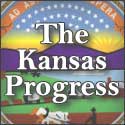A Riddle for KC: What's Greener Than Light Rail?

Tune in for what's new in Kansas: It's a web-based news site, and regularly published journal, dedicated to limited government in the great state of Kansas. |
![]()
© Jack Cashill
Published in Ingramsonline.com - May 2012
Without spending a dime—for passenger fare or tax subsidies—Kansas City already has the Downtown connectors it needs. We call them ‘shoes.’
Like every other city in America, Kansas City aspires to be the new Portland—youthful, compressed, trendy and autophobic to the point of the pathological.
For its dysfunctional hipness, Portland has been celebrated more often in the travel pages of the New York Times these past few years than Prague and Paris combined. Kansas City, however, has the potential to push Portland back to the pages of the Oregonian, where it belongs.
To do so, we need to outflank Portland on the one side that will get the Times’ attention—the green side—and this we can do in an entirely sensible way.
Here is the situation. The Crown Center area has developed a series of attractions, many of them new. These include LegoLand and Sea Life at Crown Center itself and the World War I Museum across the street. Meanwhile, Union Station has come back to life, and Science City is still a draw. Of course, too, the area has more than 1,000 quality hotel rooms with meeting spaces and the like.
Meanwhile, Downtown has been resuscitated back to viability with the Power & Light District, the Sprint Arena, and now the Kauffman Center for the Performing Arts. The net result is a literally bi-polar Downtown, and the challenge is to connect these poles roughly a mile apart.
The zombie solution, one that refuses to die, is light rail. Let’s take a quick detour to Portland to see how light rail works at its iconic best. In the way of background, Congress passed a law in the 1970s allowing federal highway funds to be used on capital improvements for public transportation. No mayor hoping to be re-elected would ever spend a city’s own money to do what Portland was about to do.
Having already established an “urban growth boundary,” Portland civic leaders chose to invest the federal money in an elegant but exorbitantly expensive mode of transport that would presumably make it easier for residents to live within the city’s artificially constricted borders.
Mayor Neil Goldschmidt—the youngest and hippest in the country at the time—seems to have learned his M.O. at the feet of Boss Tom Pendergast. Like any self-respecting city boss, Pendergast had used his control of Kansas City streetcar lines to manipulate land use along the routes for votes and profit.
In his post-mayoral, post-gubernatorial career, Goldschmidt did something similar. Apparently, his consulting clients were gaming the system for rail construction contracts and subsidies for high-density development along the right-of-way.
The good citizens of Portlandia were shocked when the machinations of the “light rail mafia” came to light (in the Oregonian, not the Times). But let’s face it, an entity known as “the state integrated land use and transportation planning system” had cluster back-scratch written all over it from the beginning.
The light rail never worked as envisioned in any case. Since the city launched the project in the 1980s, overall use of public transit declined from 9.8 percent of the market to 7.6 percent, largely because the cost of light rail put the squeeze on bus routes. If it matters, the fastest light-rail line in Portland averages 22 miles per hour, the slowest about 7. If I am in Portland, like 90-plus percent of its citizens, I am driving.
What is greener than light rail (and only slightly slower)? Answer: Walking. This is an option that one of the participants at Ingram’s Hospitality and Tourism Industry Outlook last month offered, and it seemed worthy of exploration.
The stretch on Wyandotte Street from Bartle Hall to Union Station is less than a mile. To put this in perspective, the last time I was in New York City, I walked from Rockefeller Center to the Metropolitan Museum of Art, a walk at least twice as long, and no one offered me a medal. Walks of a few miles are routine in Manhattan. There is no call to build light rail there, and many tourists avoid the subway—especially after their first exposure to it.
Wyandotte has the potential to be a pole-connecting pedestrian thoroughfare. This stretch is now lined by Bartle, the Kauffman Center, the historic Webster House, and a few well-tended blocks of creative enterprises. It culminates in the Freight House restaurants and the historic Pencoyd Railroad Bridge, rebuilt as a pedestrian link to Union Station.
The stretch could use a little more retail, but this should happen naturally. If foot traffic reached critical mass, the city could make the street strictly pedestrian. Hell, given where we are located—most tourists think we’re in Kansas—let’s just call it the “Yellow Brick Road,” splash some yellow paint around, show people where to walk, and start working out the details.
The Un-Portland
As another Industry Outlook participant suggested, Kansas City can readily solve the other tourist challenge, namely connecting all the dispersed area attractions to Downtown. This solution we hide from the Times. It is totally un-Portland.
We begin by acknowledging that all our attractions—except the “riverboats”—are pretty much where they ought to be and where they are destined to stay. That includes the ballparks, the Kansas Speedway, the Truman Library, the zoo, the Steamboat Arabia Museum, 18th and Vine, the Nelson, the American Royal, the Plaza, and more.
The question remains: how do tourists get to these sites? Well, most tourists simply drive there. The sites all have free, ample parking, which is essential in the un-Portland. Truth be told, a native Midwesterner would rather pay for sex or psychiatry than pay for parking.
Any public official who suggests “rail”—in any form—as a way to get people to and from these attractions should be summarily fired, if not institutionalized. That is pure madness.
No, in the un-Portland scheme, the tourists come to Union Station. There they find a display board of all the possible destinations and the fixed, per-passenger cost to get to a given destination on one of the many entrepreneurial jitneys lined up in front.
To be sure, there would be details to work out, but it would cost less in time and money to launch this system than to do still another feasibility study on rail of any sort.
There was a good reason why Kansas City pulled up the majority of its trolley tracks a few generations back. Perhaps this would be a good time to remind ourselves why.


